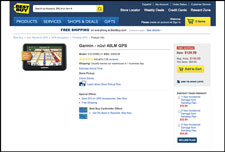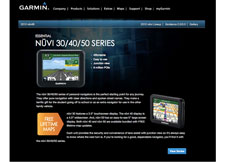With 167 million Americans spending $226 billion online this year – much of it through websites such as Amazon, eBay or Walmart.com – you may be losing control of your brand.
Follow US! |
An ability to accurately present your brand and fully describe your products is now more than ever in the hands of companies and websites you don’t directly control.
For example, Best Buy sells the Garmin nuvi 40 GPS with minimal product information and literally no true brand messaging:
Through its own site, however, Garmin is able to present the same product series in a much more branded and customer relevant way:
This is not to suggest that Garmin walk away from selling through third parties. It does, however, highlight three things:
1. Merchants need to be extremely aware of how their product is being presented on third-party etailer sites
2. merchants need to take full advantage of every opportunity to maximize their ‘shelf-space’ on these sites
3. now more than ever, it is critical to build a strong customer relevant brand
Consumers appear online at varying points in the product buying cycle – awareness, consideration, research, and purchase – not to mention post-purchase service and social feedback and participation.
These same consumers have varying degrees of commitment and emotional involvement in your brand and its products. This is where and when merchants are most at risk.
Garmin competitor TomTom has their 5-inch GPS shelved below the nuvi 40 on Amazon. With the exception of product names, limited product information and comparable pricing, the presentation is strikingly similar:
With many things being ‘equal’ – the role and importance of a strong brand can make the difference. The online etail shelf space is crowded, competitive and at times cruel. At the point a consumer sees your product presented, the power of your brand and the relevance of your product can be the deciding factor.
Studies have shown that 90% of buying decisions are driven by emotion. Good brands are able to tap in to this emotion in an affective and relevant way. Unfortunately, few brands are truly good at this. One study suggests that only 20% of brands today have a relevant or differentiating message.
So what do you do to make the most out of this digital shelf space? Here are some simple dos and don’ts to consider:
Do
1. Support individual product sales by building and defending your brand
2. Be consistent in your brand presentation
3. Take advantage of etailer ‘extra’ product presentation and branding opportunities in order to make the most of your shelf-space
4. Consider using content syndicator services such as Webcollage to help you develop product content and deliver it across a host of etailer sites
5. If you can’t leverage etailer extras (there is a cost for doing so) – focus on those products where there is an important competitive shelf-space situation
6. No matter who is building and maintaining your product content, make sure someone is reviewing copy from a marketing standpoint. Often times this means having someone outside of IT or the web team responsible for making product information sell off the page.
Don’t
· Forget that while ‘bricks and mortar’ shopping still commands the majority of US product sales, the role of online sales and etailing will continue to expand. By 2016, 192 million Americans will spend $327 billion online.
· Don’t totally rely on the etailer to sell your product. Ultimately, the sale is your job. The etailer is responsible for providing the shelf-space. You are responsible for how the product is packaged and presented to the world – no matter where that world may be.
Chad Giddings is EVP, marketing and planning, at J.Schmid & Associates.


